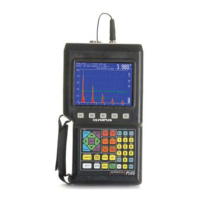138
EPOCH 4PLUS
Figure 90 Sizing Defects
When DGS/AVG is activated, the operator can adjust the scanning gain in the instrument.
This moves the DGS/AVG curves as well as the on-screen echoes up and down. DGS
curves are also dynamically adjustable with the RANGE function if necessary.
When using the DGS/AVG function, it is possible to evaluate defect echoes that do not
break the instrument’s gate. In the screen above (right), an echo is being evaluated and
rated as FBH 1.21 mm even though it is not breaking the gate. Soundpath measurements
are not displayed unless the echo is breaking the gate.
9.13.4 DGS/AVG and the EPOCH 4PLUS Datalogger
DGS/AVG setups and inspection results can be stored in the EPOCH 4PLUS datalogger.
If data is saved using the [SAVE THICK] key, the instrument will only store the file
name, ID, and measurement value (soundpath, not DGS/AVG evaluation). If data is
stored using the [SAVE WAVE] key, the instrument will store the file name, ID,
measurement(s), DGS/AVG evaluation (dB or FBH), Registration Level, all instrument
setup parameters, and the A-Scan.
When a DGS/AVG calibration is recalled from the datalogger, the instrument displays a
screen similar to the screen below:

